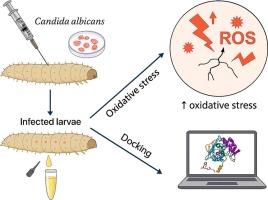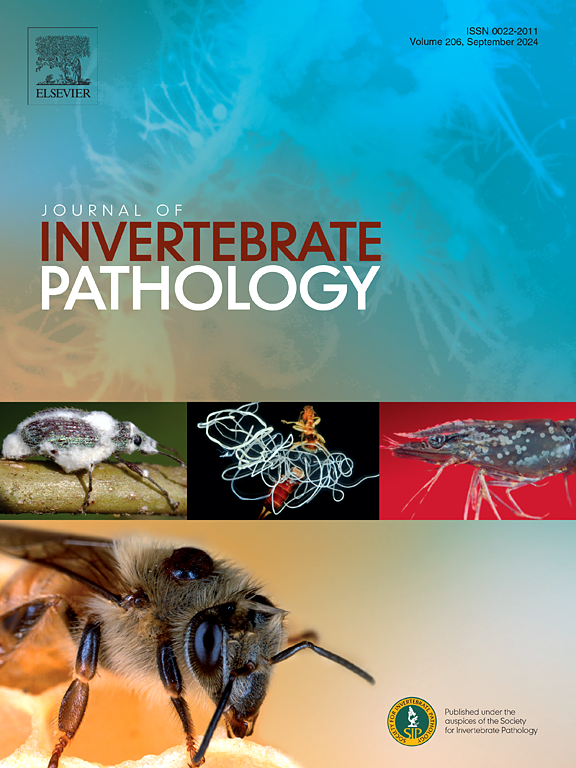Oxidative stress and antioxidant responses in Galleria mellonella following Candida albicans infection
IF 2.4
3区 生物学
Q1 ZOOLOGY
引用次数: 0
Abstract
Candida albicans is one of the most common human fungal pathogens. C. albicans infections can range from superficial conditions, such as oral and vaginal candidiasis, to more severe, invasive infections, which can lead to life-threatening systemic diseases, particularly in immunocompromised individuals. In this study, the oxidative effects of C. albicans infection on the non-vertebrate model Galleria mellonella, were investigated. Levels of oxidative damage indicators, lipid peroxidation product, malondialdehyde (MDA), and antioxidant enzymes, including glutathione S-transferase (GST), superoxide dismutase (SOD), and catalase (CAT), were determined in C. albicans-infected G. mellonella larvae. Initially, CAT activity decreased at 2–4 h post-infection, followed by an increase at 6–8 h, while levels of MDA, GST, and SOD were elevated at 8 h, reflecting a dynamic antioxidant response. Furthermore, this study examines the interaction of gliotoxin, a mycotoxin, with antioxidant enzymes GST, SOD and CAT using molecular docking studies. Molecular docking revealed gliotoxin and β-glucan binding affinities of −6.8 kcal/mol with GST and SOD, and −6.5 and −7.2 kcal/mol with CAT, respectively. These findings indicate that G. mellonella provides an effective model for studying the interactions between C. albicans and the host.

白色念珠菌感染后的氧化应激和抗氧化反应
白色念珠菌是最常见的人类真菌病原体之一。白色念珠菌感染的范围可以从表面情况,如口腔和阴道念珠菌病,到更严重的侵入性感染,可导致危及生命的全身性疾病,特别是在免疫功能低下的个体中。在本研究中,研究了白色念珠菌感染对非脊椎动物模型mellonella的氧化作用。测定了白僵菌感染的白僵菌幼虫的氧化损伤指标、脂质过氧化产物、丙二醛(MDA)和抗氧化酶(谷胱甘肽s-转移酶(GST)、超氧化物歧化酶(SOD)、过氧化氢酶(CAT)水平。最初,CAT活性在感染后2-4小时下降,随后在6-8小时上升,而MDA、GST和SOD水平在8小时升高,反映出动态的抗氧化反应。此外,本研究通过分子对接研究探讨了真菌毒素胶质毒素与抗氧化酶GST、SOD和CAT的相互作用。分子对接显示,胶质毒素和β-葡聚糖与GST和SOD的结合亲和度分别为−6.8 kcal/mol,与CAT的结合亲和度分别为−6.5和−7.2 kcal/mol。这些发现为研究白色念珠菌与宿主的相互作用提供了一个有效的模型。
本文章由计算机程序翻译,如有差异,请以英文原文为准。
求助全文
约1分钟内获得全文
求助全文
来源期刊
CiteScore
6.10
自引率
5.90%
发文量
94
审稿时长
1 months
期刊介绍:
The Journal of Invertebrate Pathology presents original research articles and notes on the induction and pathogenesis of diseases of invertebrates, including the suppression of diseases in beneficial species, and the use of diseases in controlling undesirable species. In addition, the journal publishes the results of physiological, morphological, genetic, immunological and ecological studies as related to the etiologic agents of diseases of invertebrates.
The Journal of Invertebrate Pathology is the adopted journal of the Society for Invertebrate Pathology, and is available to SIP members at a special reduced price.

 求助内容:
求助内容: 应助结果提醒方式:
应助结果提醒方式:


